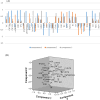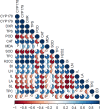Impact of varying light intensities on morphology, phytochemistry, volatile compounds, and gene expression in Thymus vulgaris L
- PMID: 40009615
- PMCID: PMC11864514
- DOI: 10.1371/journal.pone.0317840
Impact of varying light intensities on morphology, phytochemistry, volatile compounds, and gene expression in Thymus vulgaris L
Abstract
Light is a crucial factor in plant growth and development. Plants exposed to light stress experience various effects on their growth. This research was conducted to investigate the effects of different light intensities on morpho-physiological traits, phytochemical compounds, and gene expression related to the biosynthesis of voletile in Thymus vulgaris L. The results demonstrated that light intensity (20, 50, 70 and 100%) had a significant impact on morpho-physiological characteristics, pigments content, antioxidant enzymes activities, as well as the content of MDA, H2O2, anthocyanin, thymol, carvacrol, phenols, flavonoids, essential oils, and monoterpenes. Moreover, the expression of the biosynthesis genes of monoterpene compounds was significantly influenced by light intensity. While an increase in light intensity led to higher leaf count (164.6%) and biomass (33.5%), it was accompanied by a decrease in leaf area, stem length, and internode length. The highest levels of chlorophyll a (4.92 mgg-1 FW) and b (1.75 mgg-1 FW), carotenoids (907.31 µ Mg-1FW), MDA (9.93 µ Mg-1FW), anthocyanin, SOD (29.62 Umg - 1 Protein), thymol (41.2%), and carvacrol (4.46%) were observed at 70% treatment and decreased as light intensity increased. Also, H2O2, catalase and polyphenol oxidase activities, phenols, flavonoids, essential oils, and monoterpenes increased with higher light intensity, with the highest H2O2 concentration recorded at 100% (4.43 fold). Importantly, key genes involved in monoterpene biosynthesis, including DXR, TPS, CYP71D178, and CYP71D179, exhibited significantly enhanced expression under full light conditions compared to other light intensities. In conclusion, increased light intensity stimulated the elevation of oxidative indicators, antioxidant activity and enhancing the expression of genes involved in phytochemical compound biosynthesis and consequently leading to the accumulation of volatile compounds in Thymus vulgaris L. Future research will focus on investigating the combined effects of various abiotic stresses at the field level and extending the stress duration to evaluate potential additive effects.
Copyright: © 2025 Hashemifar et al. This is an open access article distributed under the terms of the Creative Commons Attribution License, which permits unrestricted use, distribution, and reproduction in any medium, provided the original author and source are credited.
Conflict of interest statement
NO authors have competing interests.
Figures





References
-
- Szymańska R, Ślesak I, Orzechowska A, Kruk J. Physiological and biochemical responses to high light and temperature stress in plants. Environ Experimen Bot. 2017;139:165–77. doi: 10.1016/j.envexpbot.2017.05.002 - DOI
-
- Yang B, Tang J, Yu Z, Khare T, Srivastav A, Datir S, et al.. Light stress responses and prospects for engineering light stress tolerance in crop plants. J Plant Growth Regul. 2019;38(4):1489–506. doi: 10.1007/s00344-019-09951-8 - DOI
-
- Chen F, Wang Y, Wang K, Chen J, Jin K, Peng K, et al.. Effects of Litsea cubeba essential oil on growth performance, blood antioxidation, immune function, apparent digestibility of nutrients, and fecal microflora of pigs. Front Pharmacol. 2023;14:1166022. doi: 10.3389/fphar.2023.1166022 - DOI - PMC - PubMed
MeSH terms
Substances
LinkOut - more resources
Full Text Sources

